|
Philosophers
Mortimer Adler Rogers Albritton Alexander of Aphrodisias Samuel Alexander William Alston Anaximander G.E.M.Anscombe Anselm Louise Antony Thomas Aquinas Aristotle David Armstrong Harald Atmanspacher Robert Audi Augustine J.L.Austin A.J.Ayer Alexander Bain Mark Balaguer Jeffrey Barrett William Barrett William Belsham Henri Bergson George Berkeley Isaiah Berlin Richard J. Bernstein Bernard Berofsky Robert Bishop Max Black Susanne Bobzien Emil du Bois-Reymond Hilary Bok Laurence BonJour George Boole Émile Boutroux Daniel Boyd F.H.Bradley C.D.Broad Michael Burke Jeremy Butterfield Lawrence Cahoone C.A.Campbell Joseph Keim Campbell Rudolf Carnap Carneades Nancy Cartwright Gregg Caruso Ernst Cassirer David Chalmers Roderick Chisholm Chrysippus Cicero Tom Clark Randolph Clarke Samuel Clarke Anthony Collins Antonella Corradini Diodorus Cronus Jonathan Dancy Donald Davidson Mario De Caro Democritus Daniel Dennett Jacques Derrida René Descartes Richard Double Fred Dretske John Earman Laura Waddell Ekstrom Epictetus Epicurus Austin Farrer Herbert Feigl Arthur Fine John Martin Fischer Frederic Fitch Owen Flanagan Luciano Floridi Philippa Foot Alfred Fouilleé Harry Frankfurt Richard L. Franklin Bas van Fraassen Michael Frede Gottlob Frege Peter Geach Edmund Gettier Carl Ginet Alvin Goldman Gorgias Nicholas St. John Green H.Paul Grice Ian Hacking Ishtiyaque Haji Stuart Hampshire W.F.R.Hardie Sam Harris William Hasker R.M.Hare Georg W.F. Hegel Martin Heidegger Heraclitus R.E.Hobart Thomas Hobbes David Hodgson Shadsworth Hodgson Baron d'Holbach Ted Honderich Pamela Huby David Hume Ferenc Huoranszki Frank Jackson William James Lord Kames Robert Kane Immanuel Kant Tomis Kapitan Walter Kaufmann Jaegwon Kim William King Hilary Kornblith Christine Korsgaard Saul Kripke Thomas Kuhn Andrea Lavazza James Ladyman Christoph Lehner Keith Lehrer Gottfried Leibniz Jules Lequyer Leucippus Michael Levin Joseph Levine George Henry Lewes C.I.Lewis David Lewis Peter Lipton C. Lloyd Morgan John Locke Michael Lockwood Arthur O. Lovejoy E. Jonathan Lowe John R. Lucas Lucretius Alasdair MacIntyre Ruth Barcan Marcus Tim Maudlin James Martineau Nicholas Maxwell Storrs McCall Hugh McCann Colin McGinn Michael McKenna Brian McLaughlin John McTaggart Paul E. Meehl Uwe Meixner Alfred Mele Trenton Merricks John Stuart Mill Dickinson Miller G.E.Moore Thomas Nagel Otto Neurath Friedrich Nietzsche John Norton P.H.Nowell-Smith Robert Nozick William of Ockham Timothy O'Connor Parmenides David F. Pears Charles Sanders Peirce Derk Pereboom Steven Pinker U.T.Place Plato Karl Popper Porphyry Huw Price H.A.Prichard Protagoras Hilary Putnam Willard van Orman Quine Frank Ramsey Ayn Rand Michael Rea Thomas Reid Charles Renouvier Nicholas Rescher C.W.Rietdijk Richard Rorty Josiah Royce Bertrand Russell Paul Russell Gilbert Ryle Jean-Paul Sartre Kenneth Sayre T.M.Scanlon Moritz Schlick John Duns Scotus Arthur Schopenhauer John Searle Wilfrid Sellars David Shiang Alan Sidelle Ted Sider Henry Sidgwick Walter Sinnott-Armstrong Peter Slezak J.J.C.Smart Saul Smilansky Michael Smith Baruch Spinoza L. Susan Stebbing Isabelle Stengers George F. Stout Galen Strawson Peter Strawson Eleonore Stump Francisco Suárez Richard Taylor Kevin Timpe Mark Twain Peter Unger Peter van Inwagen Manuel Vargas John Venn Kadri Vihvelin Voltaire G.H. von Wright David Foster Wallace R. Jay Wallace W.G.Ward Ted Warfield Roy Weatherford C.F. von Weizsäcker William Whewell Alfred North Whitehead David Widerker David Wiggins Bernard Williams Timothy Williamson Ludwig Wittgenstein Susan Wolf Scientists David Albert Michael Arbib Walter Baade Bernard Baars Jeffrey Bada Leslie Ballentine Marcello Barbieri Gregory Bateson Horace Barlow John S. Bell Mara Beller Charles Bennett Ludwig von Bertalanffy Susan Blackmore Margaret Boden David Bohm Niels Bohr Ludwig Boltzmann Emile Borel Max Born Satyendra Nath Bose Walther Bothe Jean Bricmont Hans Briegel Leon Brillouin Stephen Brush Henry Thomas Buckle S. H. Burbury Melvin Calvin Donald Campbell Sadi Carnot Anthony Cashmore Eric Chaisson Gregory Chaitin Jean-Pierre Changeux Rudolf Clausius Arthur Holly Compton John Conway Simon Conway-Morris Jerry Coyne John Cramer Francis Crick E. P. Culverwell Antonio Damasio Olivier Darrigol Charles Darwin Richard Dawkins Terrence Deacon Lüder Deecke Richard Dedekind Louis de Broglie Stanislas Dehaene Max Delbrück Abraham de Moivre Bernard d'Espagnat Paul Dirac Hans Driesch John Dupré John Eccles Arthur Stanley Eddington Gerald Edelman Paul Ehrenfest Manfred Eigen Albert Einstein George F. R. Ellis Hugh Everett, III Franz Exner Richard Feynman R. A. Fisher David Foster Joseph Fourier Philipp Frank Steven Frautschi Edward Fredkin Augustin-Jean Fresnel Benjamin Gal-Or Howard Gardner Lila Gatlin Michael Gazzaniga Nicholas Georgescu-Roegen GianCarlo Ghirardi J. Willard Gibbs James J. Gibson Nicolas Gisin Paul Glimcher Thomas Gold A. O. Gomes Brian Goodwin Joshua Greene Dirk ter Haar Jacques Hadamard Mark Hadley Patrick Haggard J. B. S. Haldane Stuart Hameroff Augustin Hamon Sam Harris Ralph Hartley Hyman Hartman Jeff Hawkins John-Dylan Haynes Donald Hebb Martin Heisenberg Werner Heisenberg Grete Hermann John Herschel Basil Hiley Art Hobson Jesper Hoffmeyer Don Howard John H. Jackson William Stanley Jevons Roman Jakobson E. T. Jaynes Pascual Jordan Eric Kandel Ruth E. Kastner Stuart Kauffman Martin J. Klein William R. Klemm Christof Koch Simon Kochen Hans Kornhuber Stephen Kosslyn Daniel Koshland Ladislav Kovàč Leopold Kronecker Rolf Landauer Alfred Landé Pierre-Simon Laplace Karl Lashley David Layzer Joseph LeDoux Gerald Lettvin Gilbert Lewis Benjamin Libet David Lindley Seth Lloyd Werner Loewenstein Hendrik Lorentz Josef Loschmidt Alfred Lotka Ernst Mach Donald MacKay Henry Margenau Owen Maroney David Marr Humberto Maturana James Clerk Maxwell Ernst Mayr John McCarthy Warren McCulloch N. David Mermin George Miller Stanley Miller Ulrich Mohrhoff Jacques Monod Vernon Mountcastle Emmy Noether Donald Norman Travis Norsen Alexander Oparin Abraham Pais Howard Pattee Wolfgang Pauli Massimo Pauri Wilder Penfield Roger Penrose Steven Pinker Colin Pittendrigh Walter Pitts Max Planck Susan Pockett Henri Poincaré Daniel Pollen Ilya Prigogine Hans Primas Zenon Pylyshyn Henry Quastler Adolphe Quételet Pasco Rakic Nicolas Rashevsky Lord Rayleigh Frederick Reif Jürgen Renn Giacomo Rizzolati A.A. Roback Emil Roduner Juan Roederer Jerome Rothstein David Ruelle David Rumelhart Robert Sapolsky Tilman Sauer Ferdinand de Saussure Jürgen Schmidhuber Erwin Schrödinger Aaron Schurger Sebastian Seung Thomas Sebeok Franco Selleri Claude Shannon Charles Sherrington Abner Shimony Herbert Simon Dean Keith Simonton Edmund Sinnott B. F. Skinner Lee Smolin Ray Solomonoff Roger Sperry John Stachel Henry Stapp Tom Stonier Antoine Suarez Leo Szilard Max Tegmark Teilhard de Chardin Libb Thims William Thomson (Kelvin) Richard Tolman Giulio Tononi Peter Tse Alan Turing C. S. Unnikrishnan Nico van Kampen Francisco Varela Vlatko Vedral Vladimir Vernadsky Mikhail Volkenstein Heinz von Foerster Richard von Mises John von Neumann Jakob von Uexküll C. H. Waddington James D. Watson John B. Watson Daniel Wegner Steven Weinberg Paul A. Weiss Herman Weyl John Wheeler Jeffrey Wicken Wilhelm Wien Norbert Wiener Eugene Wigner E. O. Wilson Günther Witzany Stephen Wolfram H. Dieter Zeh Semir Zeki Ernst Zermelo Wojciech Zurek Konrad Zuse Fritz Zwicky Presentations Biosemiotics Free Will Mental Causation James Symposium |
Solar Panels for the Information Philosophy Institute (8/29/2019 update)
We have proposals to add more than 40 panels aligned with the roof structure, oriented to the southwest at azimuth 222° and elevation angle 21°.
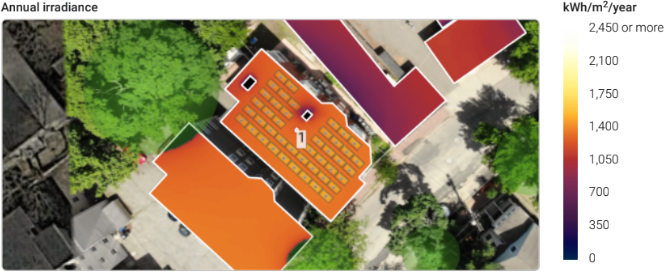
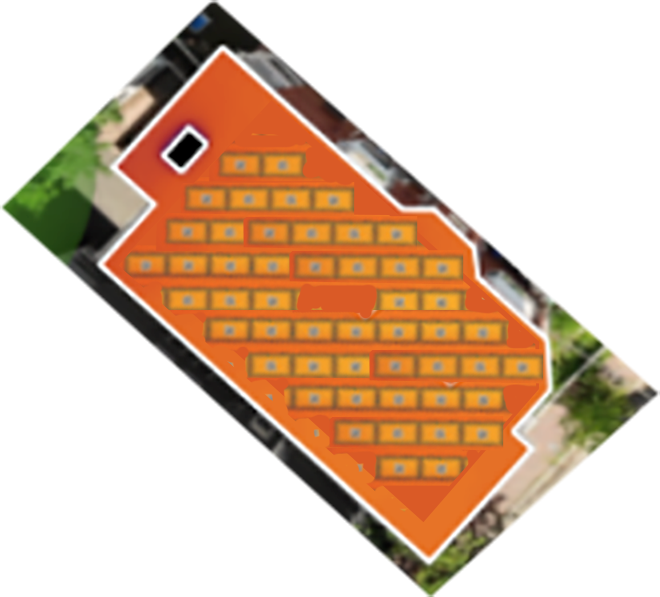
A new roof
Our major goal is a "cool roof" using a white PVC membrane to replace our black rubber roof. The secondary goal is a solar panel array that generates energy from direct sunlight as well as reflected light from the cool white roof.
We will need to strengthen the structure of the 77 Huron roof to support an array of 40+ solar panels. But the new PVC roof with the solar panels will be only about half the weight of the old two-layer roof.
The current EPDM rubber roof is past its expected life. We have maintained it by resealing the seams and adding a strip of new rubber on top of the original seams. It was put down on top of the original and very heavy built-up 3-ply (BUR) roof - roofing paper, asphalt (tar/bitumen), and gravel.
Since we will be adding approximately 5000 pounds of weight (new PVC roof - 1500, solar rack mounts - 1000, and solar panels - 2500), we must first tear off the existing roof layers. The tar and gravel roof weighs about 9,000 pounds (600 lbs. per "square"), and the EPDM and Insulation weighs 900 pounds (60 lbs. per square). So we will actually cut the roof weight in half. The distributed weight is only about 3 pounds per square foot compared to the snow load of about 40 psf.
Can we first do the roof removal and replacement with new PVC roofing, then later do the solar panel installation?
We need to take off the roofs for other reasons. We may need a plumber to inspect the roof drain pipe and perhaps strengthen it and add a new screen to catch leaves.
We also need to properly insulate the "attic" space below the decking, maybe install a thermostatically controlled ventilation fan that exhausts only summer heat. We may have to replace any weakened planks in the decking, possibly even sister bad joists.
And above all, we need to secure the decking planks to rafters/joists with 3.5" #10 deck screws.
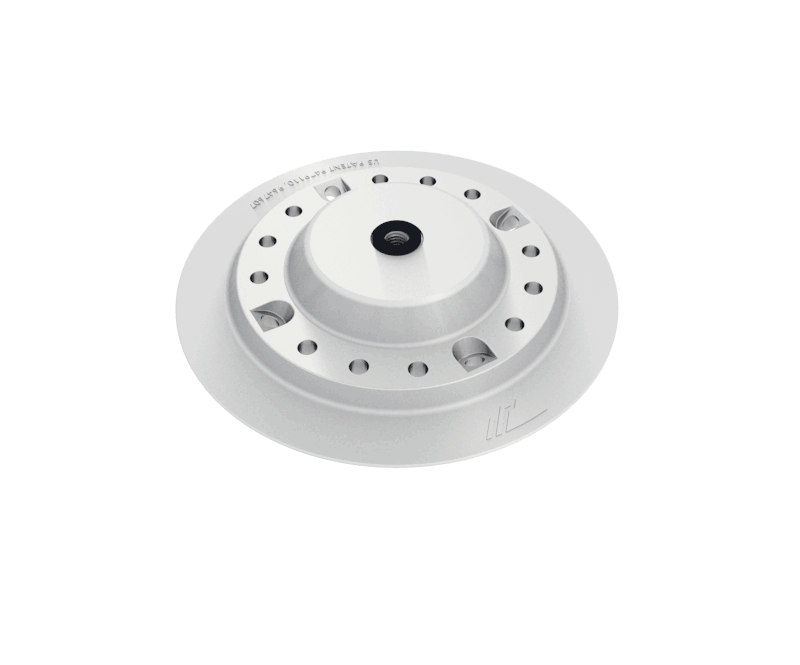 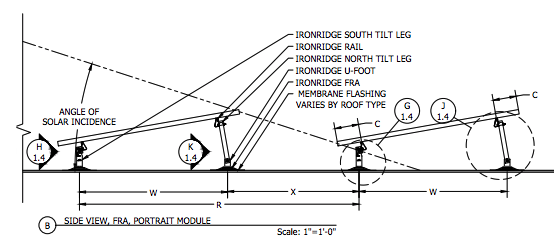 We want to understand how the new roof is fastened to the decking, and how the solar panels will be fastened to the new roof through the PVC to the decking/joists. Do we first need to install anchors to the roof decking/joists/rafters for the solar panel racks, and then install the PVC roofing?
Perhaps not. It may be easier to put on the PVC roof and screw the IronRidge FRAs through the new PVC. There would be no need to cut the PVC, just drive screws through it. We then would hot air weld the IronRidge premolded membrane over the roof attachments to the new white PVC roofing. Installing the tilt leg base would then seal the roof.
We want to understand how the new roof is fastened to the decking, and how the solar panels will be fastened to the new roof through the PVC to the decking/joists. Do we first need to install anchors to the roof decking/joists/rafters for the solar panel racks, and then install the PVC roofing?
Perhaps not. It may be easier to put on the PVC roof and screw the IronRidge FRAs through the new PVC. There would be no need to cut the PVC, just drive screws through it. We then would hot air weld the IronRidge premolded membrane over the roof attachments to the new white PVC roofing. Installing the tilt leg base would then seal the roof.
What is the best angle for solar panels?
A survey of dozens of solar panel angle studies around the world draws the obvious conclusion that the optimal panel angle is equal to the latitude (in our case 42°). At the summer solstice the sun is 23° higher in the sky (65°). In the winter 23° it is lower (19°).
The IronRidge diagram above shows an angle of solar incidence of 20°, with no shadowing of the panel behind, even in winter. 20° was recommended by some of our proposed suppliers. We might increase it to 30° or more, which shadows panels some in the winter, but increases the energy collected at all other times, more than compensating for the shadowing loss?
We need to know the values for the panel widths (W = L x cosine tilt angle) and separation (X). Only then can we know how many rows of panels will fit on the roof.
We also need to know the reduction of power output when a part of the panel is shadowed.
The shading problem
Solar panels on sloped roofs typically lie in the same plane and never shade one another.
Flat roofs with multiple rows of panels are quite different. In the winter, when the sun is low in the sky, the panel is best when it has a steep angle (65° up from flat). But at such an angle it severely shadows panels behind it. The time when the panel needs to be most upright (winter) is when it most shadows panels behind it.
Panels optimally should be tilted to be perpendicular to the sun's rays. They should normally be fixed at their latitude (for us 42°). Reduced production at the winter and summer solstice is just the cosine of 23°, 92 percent of the maximum at the equinox.
But panels tilted at 42° shade those behind at the winter solstice, when the sun is low in the sky, at elevation 19°.
Separation between panel rows needed to prevent shading.
Panels lying flat on the roof can be in contact, maximizing the collection area. But as the north end is raised up on tilt legs, they must be separated to avoid shading. Tilting them up also reduces the collection of dust pollution (and to some extent snow) on the surface.
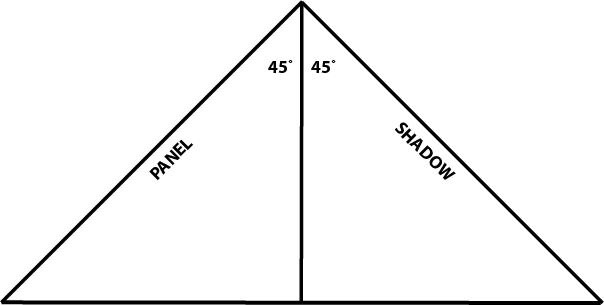

Choosing the best panel angle
What are the best solar panels?
We are leaning toward the LG NeON 2 390W 72 Cell Mono 1500V SLV/WHT BiFacial Solar Panel, LG390N2T-A5.
These panels can generate up to 30% more energy using reflected light from the roof surface. Our white PVC roof will be perfect for this.
How exactly do the LG panels deal with shadowing of individual cells? What is the power output when they are shaded 50%? That depends on which part is shadowed. Cells are arranged 6 x 12 wired in series as three strings along the long (12) dimension. In portrait orientation, all strings are affected. In landscape, only the actual strings shaded are affected. We can and must limit shading to the lower one-third in landscape orientation.
These LG panels are more expensive than many others, so tradeoffs must be considered. But in the long run, this is an investment with a very high payback in future years, so maximizing output is probably the best strategy.
What are the best panel level modules - microinverters or power optimizers?
We started with Enphase microinverters (which invert panel DC to synchronized AC), but have been advised that they may not handle the power output of the NeON bifacial (390W). This is incorrect. The Enphase IQ 7+ Micro™ (≈$140) is designed for 72-cell panels between 350W and 440W.
SolarEdge power optimizers condition the power with DC-to-DC conversions sent to a single large DC-to-AC inverter.
SolarEdge power optimizer modules, e.g., the SolarEdge P500 (≈$80) for each panel are less expensive than microinverters, but the single inverter (SolarEdge SE100K Inverter, ≈$4000) is expensive, erasing savings on the DC_DC optimizers, and has a shorter lifetime (10-12 years) than panel modules and microinverters at each panel (25 years).
Possible Phases (for different contractors?)
Tear off old roof
Crane in the garages courtyard will not require a police detail on the street.
Repair bad planks and add deck screws when roof is open.
We need to strengthen the connection between the decking/sheathing and the rafters/joists, which were built using only nails. We need strong deck screws to lock planks into the joists.
We must also renovate the storm drain pipe. Replace it with a sump bowl large compared to the current entrance hole, which has been greatly reduced by old roofing entering the 4" cast iron pipe.
We want a new PVC roof (maybe better KEE?)
Thickness? 45 mils minimum. 60 mil preferred.
Flat Roof Attachments
The IronRIdge Flat Roof Attachments (alternatively, (Anchor Products U-Anchors or now OMG PowerPlates Plus) expect to be attached directly to the roof decking.
If attachments were mounted on top of the membrane through 2" of flexible insulation, the screws would bend back and forth and eventually break under the roof membrane?
So it makes more sense to attach FRAs through the PVC membrane, essentially directly to the decking.
Sealing the penetration of the PVC membrane
Hot air welding of a PVC membrane around roof penetrating objects can be very time-consuming. (Compare labor-intensive FiberTite pipe seals and Johns Manville field-wrap pipe seals.)
By comparison, installing the IronRidge flat roof attachment (FRA) is much quicker and simpler.
1) The IronRIdge FRA is attached with 16 screws (on top of the new PVC roof). 2) The premolded membrane is centered on the FRA by inserting a bolt into the FRA, then hot air welded to the PVC (The 60 mil membrane for Carlisle PVC/KEE is FRA-M60K-CA-W1). 3) The tilt leg is bolted, with weathertight washers, into the (non-penetrating) hole in the FRA. There is no time during racking installation that the roof has openings for water penetration.
Solar Panel Installation
Permit process first.
Specify locations and install the flat roof attachments.
Hot-air weld the PVC/KEE membrane covers for the FRAs. Who does the- roofers or solar installers? Roofers - for warranty reasons.
Install solar rack mounting system on top of new roof.
Install solar panels, microinverters or power optimizers at each panel, cabling, connection to the grid, net metering, etc.
What does a net metering installation look like? Can I visit a completed installation?
A First Step?
This should be included in the permit process.
We also want to put solar panels on the roof of my Tesla garage (75 Huron). It is tar and gravel on poured concrete and has never leaked. It will not need bifacial panels (unless we also replace it with a cool white roof).
The garage has nowhere near the solar irradiance of the house, but I suspect it will pay for itself and I want it so my son Rob and I can get experience with the panels, the monitoring system, the net metering, etc.
The new solar energy would contribute directly to charging the Tesla Model 3, now in my garage and about to have 240V/40A charging once Tesla sends me the 6-50 NEMA adapter.
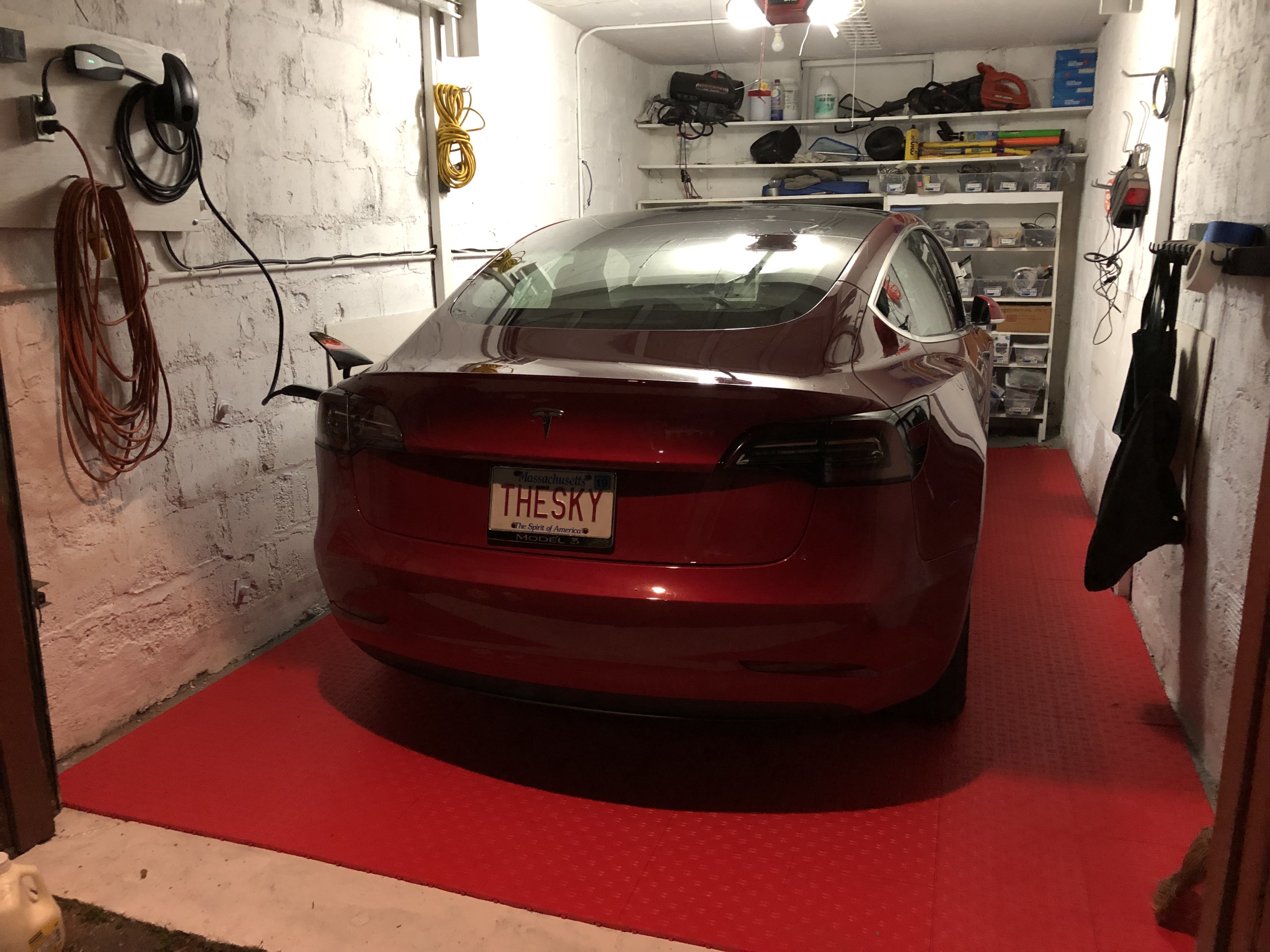 I put in a new showroom style floor in the garage to match the car..
Normal | Teacher | Scholar
I put in a new showroom style floor in the garage to match the car..
Normal | Teacher | Scholar
|